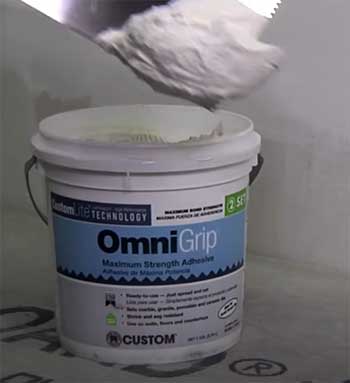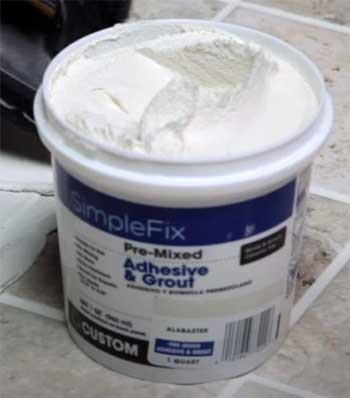To tell you the truth…both are popular ways of setting tiles on the floor. But to know which one will work better with you, read my OmniGrip vs. thinset review. It will help you decide on the best product.
Thinset is a more robust option for tile adhesion and has a low odor, but Omigrip mastic is less strong than thinset and has a striking odor.
You need more comparisons to have a complete picture of the products. You will see the features and differences between these two tile adhesives here.
A Quick Comparison Table
Here is a quick comparison table between Omnigrip and Thinset tile adhesive:
| Aspects | OmniGrip | Thinset |
| Product Type | Flexible & Lightweight Tile Mastic | Strong Tile Adhesive |
| Materials Used | Acrylic Copolymers, Calcium Carbonate, & Inorganic Materials | Portland Cement, Sand, Water |
| Adhesive Form | Liquid | Dry, Wet, Pre-Mixed |
| Benefits | Offers Many Benefits | Offers Many Benefits |
| Suitable Usage | Dry Areas | Dry & Wet Areas |
In-Depth Comparisons Between OmniGrip And Thinset
We will look into comprehensive details of these two types of tile adhesives. With all the knowledge at hand, you can decide which one will be the best fit for you.
So, here are some key differences between these products:
- Product Type

Omnigrip is a lightweight and flexible tile adhesive with less shrinkage rate than traditional tile adhesives.
You can also set various stones with this adhesive.
With high-quality materials, this product is engineered for sag resistance, random water exposure dealing, etc.
You can use it for installing small format tiles and pavers, stones, etc., in small area projects.
The recommended tile size is 12 inches to 15 inches on any side.
On the contrary, Thinset is made of inorganic and composed materials that come directly from the earth. It is a strong adhesive for installing tiles, stones, pavers, etc.
You can use this adhesive for large tiles in larger area projects.
Thinset is available in various forms and is an affordable solution with the most cost-benefit ratio. You can set any size of tiles with this adhesive.
- Materials Used
Since Omnigrip and thinset are two different types of adhesive, it’s obvious they are made of different materials. Knowing about the materials will help you understand the products better.
Omnigrip is a mastic for installing tiles and stones. It is manufactured by Custom Building Products, one of the largest manufacturers of adhesives and home improvement products.
OmniGrip is a proprietary blend of acrylic copolymers, calcium carbonate, and inorganic materials.
In contrast to Omnigrip, thinset is made of inorganic materials collected from the earth’s surface. It is made of Portland cement, sand, water, and water retention agents. Besides, it contains liquid latex polymers for added strength.
- Adhesive Form

Omnigrip is a premium quality tile and stone adhesive that comes into liquid form.
You won’t have to create any mixture as it comes ready. Apply it to the surface right out of the box.
On the other hand, thinset comes in three forms. Depending on your project time, you can use dry, wet, or pre-mixed thinset.
Dry thinset is like powders, and they are the least expensive. Besides, you will get a modified and unmodified thinset option.
Modified thinset has liquid latex polymers for added strength that unmodified thinset doesn’t have.
- Benefits
You will get high flexibility and bond strength from Omnigrip. According to my experience, it sets faster than thinset and offers about 33% less shrinkage than traditional adhesives.
Plus, it offers sag and slips resistance. Omigrip can be an excellent choice for small size tiles.
In contrast, thinset offers the most vital bond over many surfaces. You can use it for any large tile installation or redoing projects.
As it takes longer to set, you will have enough time to correct any non-aligned or imperfect tiles. Besides, it will fill any gap on your surface.
- Suitable Usage
Omnigrip mastic is suitable for various tiles, including ceramic, porcelain, mosaic, stone, etc. You can use it on concrete, mortar beds, masonry, existing ceramic tiles, etc., substrates.
Besides, it works perfectly on kitchen walls, backsplashes, bathroom walls, shower tub surrounds, etc.
By contrast, thinset is used for installing various tiles and stones on large areas. It also works on masonry, concrete, mortar, and other substrates.
You will get an excellent result by applying it to shower walls, shower pans, bathroom floors, bathroom walls, kitchen walls and floors, countertops, etc.
Which Adhesive Is Best For You?
If you summarize my discussion, you will see that OmniGrip offers the hardest adhesion in a small area for various types of tiles. It dries and sets tiles faster than thinset.
But in contrast, thinset offers the best value for money. It is suitable for large tiling projects.
So, before choosing one consider your project size. If you plan to install or redo tiling for an entire home, you should go for a thinset. But if it’s just one room, OmniGrip can be a better option.
Frequently Asked Question (FAQ)
Omnigrip is a strong tile adhesive used for various types of tiles, including porcelain, ceramic, mosaic, stone, etc. You can use it on kitchen walls, backsplashes, bathroom walls, etc.
Both are good products. Tile adhesive is suitable for small projects and vertical applications. But thinset is good is large projects and horizontal applications.
Omnigrip is not designed to be used for damp areas because of the moisture factor. So, you should not use it in the shower.
Tile adhesive and thinset are two different products. They are made from different types of materials.
Final Thoughts
Choosing between tile adhesive and thinset can be challenging, especially if you are not a pro. But after reading about OmniGrip vs. thinset, you should have any confusion left.
I’m sure you could decide between these two options already. Both are good products with some pros and cons.
So, I suggest you choose one according to your project requirement. Let me know what you think.
